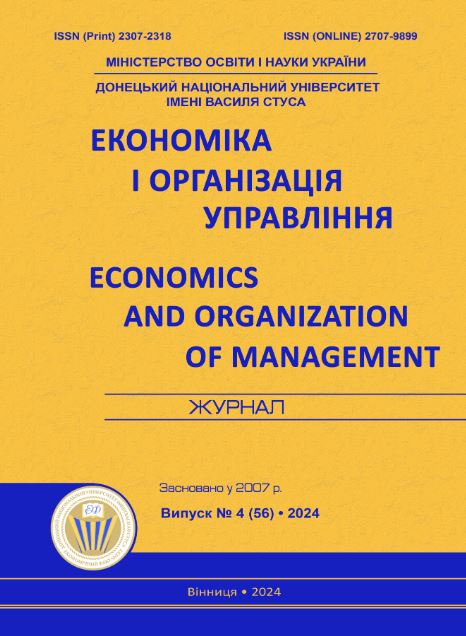Key indicators of performance as a tool for improving the management of organizations
DOI:
https://doi.org/10.31558/2307-2318.2024.4.7Keywords:
management system, management efficiency, key performance indicators (KPI), balanced scorecard (BSC), public sector enterprises, stakeholders, human capital development, BSC framework, sustainable development, long-term partnershipsAbstract
The paper formulates the goal of defining key performance indicators as a tool for improving the management of organizations using public law enterprises as an example, and develops recommendations for building a system of key indicators for the Vinnytsia Regional State Laboratory of the State Production and Consumer Service.
Improvement of the management system of organizations is based on management performance indicators, which act as key indicators of the organization's ability to ensure stable operation and development over a long time horizon. The concept of efficiency is identical to the terms "effectiveness", "productivity" and "economy", but each of them has its own content and direction, which makes such identification inappropriate.
The issue of the effectiveness of management systems of public law enterprises is specific in comparison with the business environment. Common features are associated with the influence of market competition conditions, and features are determined by the influence of social and government obligations, when the goal of making a profit is intermediate, the essence of their activities is to provide public goods, which involves taking into account both economic parameters and social, environmental factors in the development of management systems of public law enterprises. Among the key performance indicators as tools for improving the management of public law enterprises, it is necessary to define the rational, targeted and economic use of budgetary funds and resources, the balance between flexibility and strict regulation of a normative and legal nature; the presence of an intangible nature of the final results and their general direction in ensuring public goods; a high degree of influence of stakeholders, whose interests and actions may be contradictory.
Based on these factors, the feasibility of using the BSC at public law enterprises, the need to adapt this system to the complex tasks of government agencies, in the context of resource optimization, increasing transparency, accountability, anti-corruption and responsibility in management, as well as meeting the needs of various target groups of consumers of public administrative services, are determined.
Accordingly, the key indicators of the BSC need to be adapted to each sector of public administrative services. Using the example of the VRDL of the State Production and Consumer Service, the requirements for key performance indicators are considered, and cause-and-effect relationships between the blocks and indicators within each of the blocks are determined. The analysis of the blocks was carried out and the final KPI indicators were formed to assess their importance for the VRDL of the State Production and Consumer Service (for the development of human resources) and their importance for the market (as perceived by customers, their views on the quality of research) according to the criterion of intersection of these profiles.
It was determined that the use of key performance indicators will increase the competitiveness of the VRDL of the State Production and Consumer Service, will contribute to strengthening its position in the market, increasing revenues and sustainable development.
A balanced scorecard of the VRDL was built to improve the efficiency of the management system, which consists in increasing the number of new customers in strategic segments (in the food industry, agricultural sector, veterinary medicine); reflects the transparency and availability of information for customers; measures the level of digitalization in interaction with customers; shows the level of long-term partnerships.
References
Державна служба України з питань безпечності харчових продуктів та захисту споживачів URL: https://dpss.gov.ua
Місько Г.А. Сутність поняття результативність та ефективність в менеджменті. Науковий вісник Одеського національного економічного університету. 2020. No 3–4 (276–277). С. 97–102.
Назаренко І. Економічний зміст ефективності діяльності підприємств. Галицький економічний вісник. 2022. No 3(76). С. 15–22.
Нечипорук А., Таранич О. Управління ефективністю виробничої діяльності підприємства: сутність та значення. Економіка та суспільство, 2023. №56. С. URL: https://economyandsociety.in.ua/index.php/journal/article/view/3104/3028
Селезньова Г.О., Іпполітова І.Я. Оцінювання ефективності системи управління підприємством. Ефективна економіка. 2020. № 3. URL: http://www.economy.nayka.com.ua/pdf/3_2020/54.pdf
Сорока А. М., Венгуренко І. М. Стратегії системи менеджменту в сфері управління підприємствами. Економіка. Менеджмент. Бізнес. 2021. № 3. С. 23-28.
Таранич О. В., Вісіцька Д. О. Мотивація державних службовців у системі адміністративного менеджменту. Економiка i органiзацiя управлiння. 2021. № 1 (41) DOI 10.31558/2307-2318.2021.1.11
Череп А.В. Формування ефективної системи управління підприємствами. Вісник Хмельницького національного університету. Економічні науки. 2021. № 6(2). С. 280-286.

